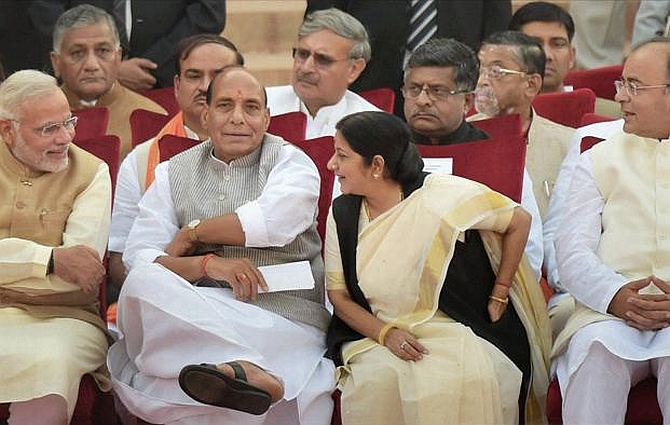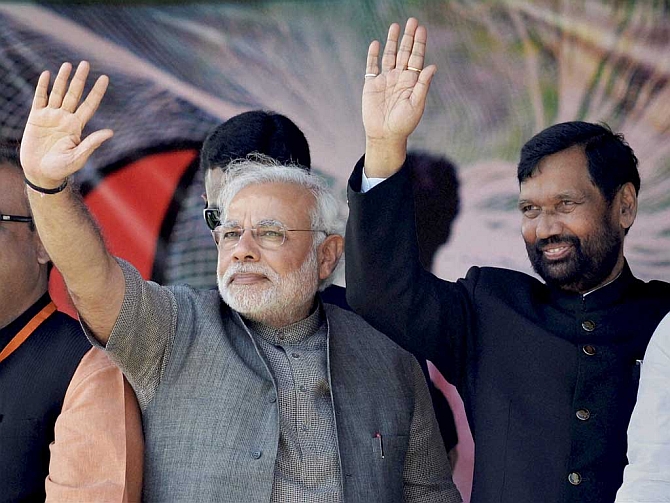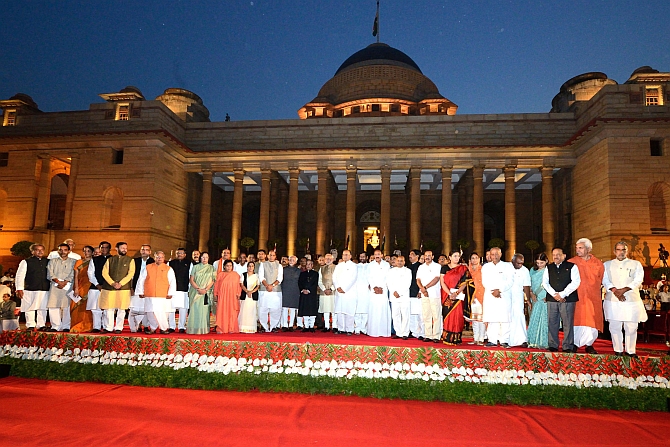
In the formation of the council of ministers, the compulsions of keeping the party leaders and alliance partners happy took precedence over the goal of rationalising existing ministries
The composition of Prime Minister Narendra Modi's council of ministers was made official on Tuesday. With 23 Cabinet ministers, 10 ministers of state with independent charge and 12 ministers of state, Modi's council is certainly one of the smallest in recent times.
But the reason why it will still count as a disappointing exercise is that it fails to live up to the high expectations raised by Modi's earlier slogan of "minimum government, maximum governance". Those expectations rose further after the impressive electoral victory of the Bharatiya Janata Party, which secured a majority in the Lok Sabha on its own and, therefore, made itself less prone to compulsions of a coalition government. Several important issues have, therefore, arisen after the announcement of Modi's ministerial team and it will be instructive to look at each of them.
…

First, let us look at the age profile of Modi's council of ministers. Only nine ministers in his council are older than the prime minister. The remaining 36 ministers are younger than Modi, who will be 64 this September. Of the nine ministers, six are older than Modi by just around two years -- Rao Inderjit Singh is older by just a few months; Venkaiah Naidu, Gopinath Munde and Radha Mohan Singh by about a year; and Thawar Chand Gehlot and Santosh Kumar Gangwar are older than Modi by about two years. T
These six ministers, strictly speaking, belong to Modi's age group. The real seniors in the council of ministers are Najma Heptulla, born in 1940; Kalraj Mishra, born in 1941; and Ram Vilas Paswan, who was born in 1946. They are the only ministers in this government who were born before India gained independence in 1947.
So the question is: what was Modi's age criterion for inclusion in the council of ministers? Or was there any age criterion at all? The question of an age criterion arose after reports emerged that those born before 1950 would not be considered for inclusion in the council of ministers.
Another theory was that Modi had toyed with the idea of a cut-off for those who were over 75 years, something similar to what Ratan Tata had introduced as the head of the Tata group. Tata had ordained that those above 65 years must step down from all executive positions and could continue in non-executive roles initially till 75 years, which was later revised downwards to 70 years.
…

Going by this criterion, Lal Krishna Advani and Murli Manohar Joshi, both octogenarians, ruled themselves out because of their age. But if Heptulla, Mishra and Paswan could make the cut because they were below 75 years, surely age was not a problem for either Arun Shourie or Subramanian Swamy. It would, thus, appear that more than age as a criterion, there were other important factors at play.
One such factor, perhaps, was loyalty. Modi made it clear through his ministry formation that those who were not part of his team or the inner circle would not be favoured with a ministerial berth. Neither Shourie nor Swamy could claim to be a member of Modi's inner circle. In contrast, if you are a loyal member of the Modi team, electoral performance would hardly make a difference.
…

Two key members of Modi's cabinet lost the Lok Sabha elections. Yet they were given key portfolios -- Arun Jaitley got the ministries of finance and corporate affairs and Smriti Irani got the coveted portfolio of human resources development.
And not being a member of either of the Houses in Parliament did not come in the way of a team member -- Nirmala Sitharaman -- getting the key ministry of commerce and industry as minister of state with independent charge.
Even the grand idea of rationalising ministries and integrating some of them to create super-ministries for transport, agriculture, including food, infrastructure and energy was executed half-heartedly and without conviction.
Thus, corporate affairs was rightly clubbed with the finance ministry, thereby making the implementation of corporate laws and monitoring them a little less cumbersome. But the same logic was not used in several other cases, as political expediency and the appeasement of coalition partners became more important. Thus, only two of the four transport ministries were clubbed together, leaving the railways and civil aviation to be shepherded by two other Cabinet ministers.
…

Similarly, small industries, chemicals and fertilisers, and heavy industries continued to be led by three different ministers, and agriculture, food and food processing were kept under three different Cabinet ministers. The compulsions of keeping the party leaders and alliance partners happy took precedence over the goal of rationalising ministries that over the years had become oversized and unwieldy.
Yet the clear impression at the end of this exercise was that one more round of expansion of the council of ministers will take place by the end of July.
Placing the defence ministry under the temporary charge of the finance minister shows how incomplete Tuesday's exercise was. The next exercise may well take the size of the council of ministers closer to that in the Atal Bihari Vajpayee government.
Coalition pressure or no pressure, it seems that fundamental restructuring of the government is not going to be easy even if a strong leader like Narendra Modi is at the helm.